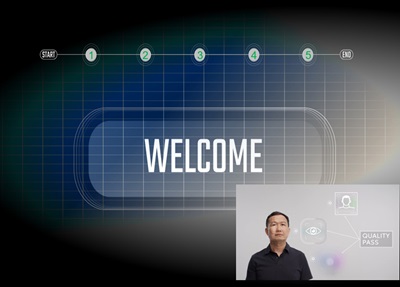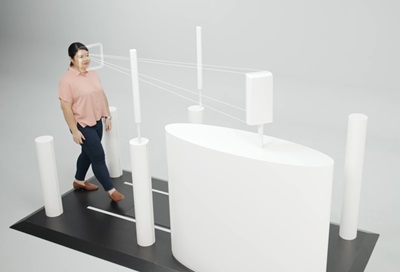Next-Generation Clearance Concept
(a) AI Augmented Multi-Modal Biometrics Self-Enrolment Kiosk

(Photo: HTX)
This is a proof-of-concept exploratory project aiming at enhancing current biometrics enrolment service involving three different biometric modalities – face, iris, and fingerprint – to achieve greater enrolment effectiveness and efficiency,
reduced manual involvement, and greater user experience.
Current State
- Today, biometric enrolment is widely carried out with in-person guidance to ensure veracity and quality of enrolled biometric images. This operational model translates to an appointment-based service entailing protracted lead time. For the service
provider, it also presents a competing demand for manpower, which could otherwise be more gainfully deployed for roles with higher operational values.
Developmental Efforts
- Pursued through in-house development efforts, deep learning was explored for AI augmentations such as detecting and prompting for the correct finger, replicating human expertise for real-time quality assessment of rolled fingerprints, and real-time
detection and prompting for mask removal during facial authentication.
Coming Next
- Development interests on the horizon include digital manipulation detection, augmented liveness detection, and 3D fingerprint imaging.
(b) On-The-Move Multi-Modal Biometrics Clearance

(Photo: HTX)
”Walk, Look, Clear” Clearance
- This exploratory development project aims to transform today’s biometrics clearance, from a stop-and-go process to a simplified three steps experience: “Walk, Look, Clear”.
- This project aims to reimagine the entire user biometric clearance experience by challenging and redefining tech boundaries to scan, identify, and authenticate users on the move, thereby transforming biometric clearance to achieve greater user-centricity.
Current State
- Current biometrics technology (for example iris scanning) works at a fixed close-up distance, requiring high level of user cooperation, with the overall experience being scanner-centric rather than user-centric, rendering it time-consuming at times.
Developmental Efforts
- Developmental fronts for enabling high speed and accurate biometric identification include long-range high resolution scanning with range sensing based device synchronisation, high frame rate image acquisition, device-optimised algorithms to handle
user-related variables such as different walking paces, stride lengths, and heights in addition to environmental conditions.
- Another envisaged salient capability is to leverage multi-modal biometrics using both face and iris to achieve identification with greater accuracy.
Coming Next
- Development interests on the horizon include concurrent multi-pax clearance on the move, and emerging contactless biometrics modalities.
Supported by:

Interested to find out more or discuss further?
Do connect with us: HTX_TechX@htx.gov.sg
Related Links